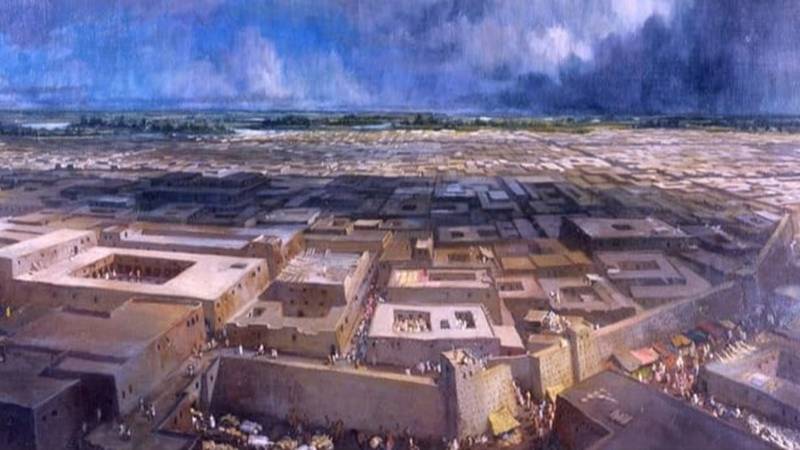
The Indus Valley Civilisation (IVC) is one of the earliest urban, state-level societies in present-day India and Pakistan. Some of its sites were also discovered in Afghanistan and Iran. It was a contemporary civilisation of Mesopotamia, Egypt & Turkmenistan. The Indus Valley Civilisation flourished between 2600-1900 BC. Its capital was Mohenjo-Daro, which has been mentioned in Sumerian Cuneiform tablets as Meluha. These tablets belong to King Sargon of Akkad 2334-2279 BC. We again read about Meluha in Gudea’s cylinder seals of 2144-2124 BC.
Indus people also had trade networks with present day Oman, Bahrain and Iran regions. The total population of the IVC is estimated 2 to 5 million people. Over all 3,781 Harappan sites have been discovered in India and Pakistan. The major cities of the Indus Valley Civilisation were Harappa, Ganweriwala, Chanhudaro, Suthkagendor, Lothal, Dholavira, Kalibangan, Rakhiagarhi and Rupar. The people of Indus had invented their own writing system. According to Mahadevan, there were more than 417 signs in the Indus script. This language is undeciphered although Dr Asko Parpola has been trying to decode Indus Script for last 52 years. Seals, weights and measures, pottery, statues, toys, jewellery have been found from the cities during excavations. These cities, towns and settlements of early, mature, late and post Indus Valley Civilisation periods were situated on the courses of Indus, Gomal, Kurram, Kabul, Ravi, Jhelum, Chenab, Sultaj, Beas, Sarasvati, Ganga and Yamuna Rivers. The civilisation was spread over 680,000 sq km.
Excavations of Indus cities from 1920s to 2020s
RD Banerji visited the ruins of Vinjnot on 20 December 1919. From December 1919 to December 1922, surveying between the present channel of the River Indus and the Khirthar Range, Banerji came across no fewer than 18 old beds of the River Indus. Banerji decided to excavate at Mohenjo-Daro at the end of the working season of 1921-22.
The discovery of the Indus Valley Civilisation and its major cities Harappa and Mohenjo-Daro was publicly announced by Sir John Marshall on the 20th of September 1924 in The illustrated London News. Afterwards, Sir John Marshall carried out massive excavations at Mohenjo-Daro from 1925 to 1927 with 1,200 to 1,500 labour. He assigned this work to Khan Sahib Ahmeddin Siddiqui, BL Dhama, K N Dikshit, Madhu Sarup Vats, Herold Hargreaves and QM Moneer. SD, L, DK, VS, HR and Moneer areas are named after these archaeologists and experts. Another excavation work was started by Mackay from 1927 to 1931 at Mohenjo-Daro. Chanhudaro was excavated during 1935-36. Harappa was again excavated in 1946 by Sir Mortimer Wheeler. He further excavated SD and L Areas at Mohenjo-Daro in 1950.
Rangpur was excavated between 1953 and 1956. Following excavation work was also done: Kot Diji (1955-57), Lothal (1956-1962), Amri (1959-1962), Kalibangan (1961-1969), Mohenjo-Daro (1964-1965), Allah Dino (1973-1983), Balakot (1973-1976), Mehrgarh (1974-1986 and 1997-2000), Dholavira (1990-2005), Lakhan Jo Daro (1994-1996-2000-2006 and 2009) and Rakhiagarhi (1969-1997-98, 1998-99, 1999-2000, and 2011,2016 and 2021)
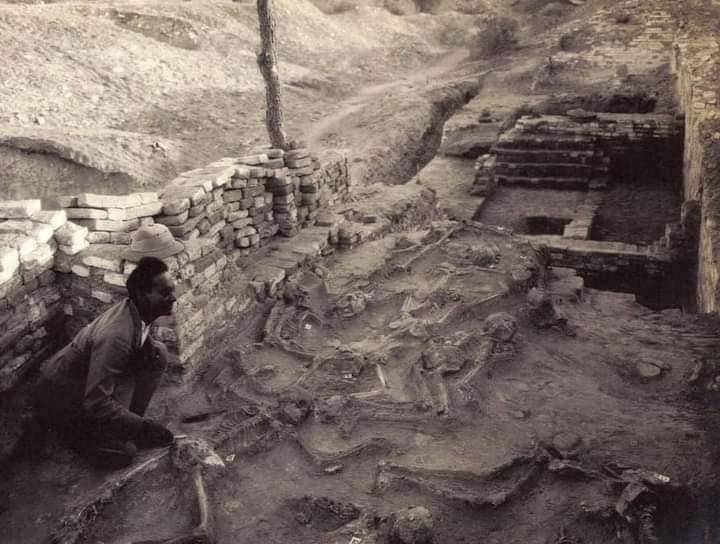
Many theories have been presented by Archaeologists, experts and historians about the decline of Indus Valley Civilisation. Some of the suggested theories are given as under.
Climate Change theory proposed by Sir John Marshall in 1931
Describing Sindh, Marshall has given details in his book Mohenjo-Daro and The Indus Valley Civilisation, 1931. In Chapter 1, he discussed The Country, Climate, and Rivers. Furthermore he puts light on the natural fertility around Mohenjo-Daro in Larkana District. He describes the situation and extent of site, climate and rainfall, Climatic changes in neighbouring districts of Balochistan, possible causes of climatic changes and changes in the river system of Sindh.
Marshall writes that, “On the contrary, there are reasons for believing that both the climate and physical aspects of the country have undergone material changes since then. Thus, that the rainfall used to be substantially heavier than it is at present, may be inferred from the universal use of burnt instead of sun dried bricks for the walls of dwelling houses and other buildings.” (Page 2)
Marshall (1931) and Sir Aurel Stein , on the basis of archaeological evidences proposed that climate in Balochistan and Sindh during Indus Civilisation period was more wet than it is present. This theory was accepted and supported by the archaeologists. This theory is also discussed by V.N. Misra (1984) in Climate, a Factor in the Rise and Fall of the Indus Civilisation-Evidences from Rajasthan. G L Possehl wrote in 2002, “The climate of this region (Indus Valley) was not markedly different in the 3rd millennium BCE from the one we have today.” In short Marshall stated that the decline was caused by the decrease in rainfall.
The Aryan invasion theory proposed by Sir Mortimer Wheeler in 1953
Invasions of the Indus Valley date back to the 3rd millennium BC. King Sargon’s grandson Naram Sin (2254-2218 BC), when listing the rebel kings to his rule, mentioned Ibra, man of Melukha. This name is found in the Royal Inscription of Gudea of Lagash (MS 2814), commemorating the defeat of Magan, Melukham, Elam and Ammuru and the establishment of regular offerings to his statue. The rebel king Ibra was no doubt Abra, chief of Meluha/ Indus Valley.
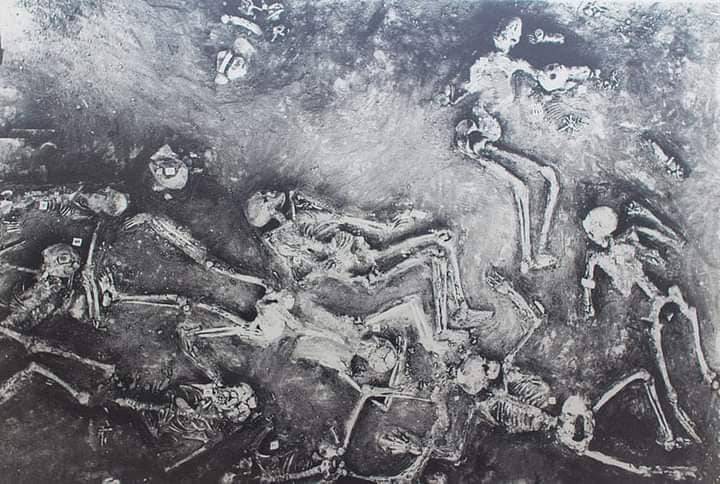
Some archaeologists and experts believe that Indo-Aryan foreigners invaded the Indus Valley plains from the north and killed Indus people. They had come from Central Asia as nomads. According to the Rig Veda (1700 BC), the chief god of the Aryans was Indra who destroyed 99 walled cities or Puras of Dravidian or black-skinned people. Mr KN Dikshit writes, “The position of some of the skeletons found in the excavations indicate the decapitation of women and children, which suggests that the inhabitants could not offer much resistance to marauders.” (Prehistoric Civilisation of the Indus Valley, 1939, Page 81)
Sir Mortimer Wheeler discovered 37 human skeletons from Mohenjo-Daro excavations in the 1950s. He believed that these people had been killed by invaders.
Sir Mortimer Wheeler, describing the end of the Indus Valley Civilisation, writes in his book Indus Civilisation (1953) that: “Relatively modern schools of writers have tried to impose the disasters of fatal wars upon capitalism, or even upon capitalists of a particular race. A historian of high repute prefers to regard war per se. without qualification, as the source of national of cultural downfall. Other theories have blamed climate, or the malarial mosquito, as overall causes. Others again prefer to stigmatise racial degeneration, variously defined or generously vague. Recently, violent geomorphological changes have been blamed for the end of the Indus Civilisation. In a particular context which other writers have either enlarged or decried beyond warrant, I once lightheartedly blamed Indra and his Aryans for this phenomenon (Page 73)
This theory was backed by GF Dales (1964) Walter A Fariservis (1971) and Srivastav (1984). The later historians have tried to connect Aryans invasions with fortifications of Dasas and Dasyus, Indra the Aryan war god and the battle of Hariyupia (Harappa). Many other archaeologists, anthropologists, experts and historians have widely written about Aryan Aryan Invasion. These include V Gordon Childe (The Aryans: A Study of Indo-European Origins), PV Kane (The Supposed Carnage of the City people by Aryans, George F Dales (The Mythical Massacre at Mohenjo-Daro), Edmond Leach (Aryan Invasions Over Four Millennia), Stuart Piggott(Conquerors from the West) and others.
This theory of Aryan invasion has been rejected now. Sir Mortimer Wheeler and Fairservise also held the exhaustion of economic resources as a possible explanation for decline. But for his part, Ihsan Nadeem Goraya, a Pakistani archaeologist and author, backs the Aryan Invasion theory.
The flood theory proposed by Robert L Raikes in 1964
Experts think the fluctuations of the River Indus had a major impact on Mohenjo-Daro. It whipped back and forth across the plains, causing floods that destroyed the agricultural base of the city. Trade and the economy were disrupted. Hundreds of villages may have been destroyed by floods or by rivers carving new channels. The same was seen in 194, 1948 and 2010 floods of River Indus.
The flood theory was proposed by Robert L Raikes. He was a British hydrologist cum archaeologist who worked with GF Dales during Mohenjo-Daro excavations. In 1964 he put forward flood theory in The American Archaeologist. His conclusion of research and fieldwork concluded like this: “Mohenjo-Daro, and inevitably all other sites in the same general areas of the Indus flood-plain were gradually engulfed by mud”. (Antiquity, XXXIX, 1965, Pages 196-203) He again expressed his views in a research paper entitled: The Mohenjo-Daro Floods (1965). Same is described by Dr George F Dales in his research article “Civilisation and Floods in the Indus Valley,” published in Expedition Magazine 1965.
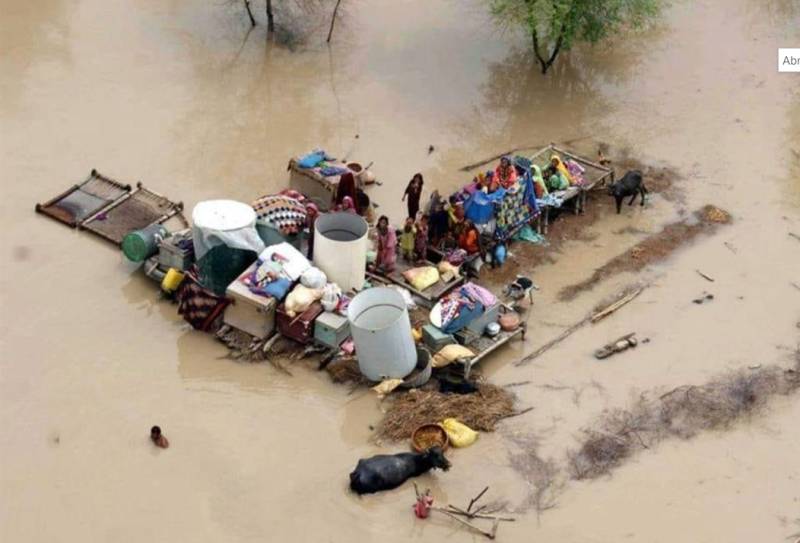
Robert L Raikes continued this work in 1967 and 1977. Raikes and GF Dales conducted surface surveys at Mohenjo-Daro during February and March 1964 and 1965 with the support of The University Museum of the University of Pennsylvania USA). They selected the southwest corner of HR Area. About 150 occurrences of silty clay were selected from SD, L, HR, VS and DK areas that seemed to correspond with flood levels. A total of 310 sherd lots were collected from 210 loci. Dales again visited Mohenjo-Daro in 1968 and rechecked sherd lots in 1979 with two graduates Jonathan Mark Kenoyer and Ilene Nicholas.
HT Lambrick has also discussed seasonal flooding of Mohenjo-Daro and other sites in Sindh in his research paper “The Indus Flood Plain and the Indus Valley Civilisation” published in The Geographical Journal Vol 133, No 4, December 1967, pages 483-495. Lambrick writes that “According to one version of the theory, this process of tectonic uplift, arrest of the Indus, creation of the great lake, and submergence of Mohenjo-Daro, must have occurred two or three times, at intervals of perhaps as many centuries. In another version, barriers of this nature, productive of like effects, are thought to have been thrown up across the Indus plain at points much nearer the sea than the position of that assumed to have caused the ruining of Mohenjo-Daro.” Raikes also discussed in 1968, “The Death from Natural Causes of Kalibangan and other Sites in Yamuna River Channel” due to shifts in the river course.
Plate tectonic uplift of the Makran coast proposed by Dr GF Dales in 1966
The evidence for this simple and indisputable Harrapan sea ports along the Makran coast, such as Suthkagendor (Gawadar), Sokhta Koh (Pasni), and Bala Kot (Lasbela) are now as for as 50 Km inland. Dr GF Dales writes in this regard: “These displayed ports made it evident that the coastline of Pakistan had risen considerably during the past 4,000 years, with the initial rise apparently having occurred during the Harappan period” (“The Decline of the Harappans” - Scientific American Vol 214 No 5, May 1966)
Due to the tectonic uplift along the Makran Coast many of the Indus Settlements were landlocked and abandoned.
Theory of aridity proposed by Gurdip Singh in 1971
Gurdip Singh did palynological study of the three lakes of Rajasthan in India. It was about a wet climate during the Mature Phase followed by a sharp decline in rainfall around 2000 BC. Irfan Habib in his book entitled The Indus Civilisation, India 2002 writes that:
"On the basis of his work on pollen samples from some saline lakes of northern Rajasthan, he claimed that, around 2230 BC, a wet phase was replaced by a dry one with much lower rainfall, as a result of which the Sarasvati (the name erroneously given to the Ghaghar-Hakra river) dried up. It is supposed that this caused a natural disaster of immense magnitude to Indus settlements in the Ghaghar-Hakra basin, from which the civilisation could not recover" (Page 63)
Theory of the sharp decrease in trade with Mesopotamia at the end of the 3rd Dynasty of Ur, proposed by Ghosh in 1980
Sometime around the end of the Third Dynasty of Ur, trade between Mesopotamia and Meluhha (Indus Valley) dropped off, supposedly because the Sumerians turned to Egypt and Arabia for the majority of their imported goods. Harappan artifacts are found in southern Mesopotamia up until about 1800 BC.
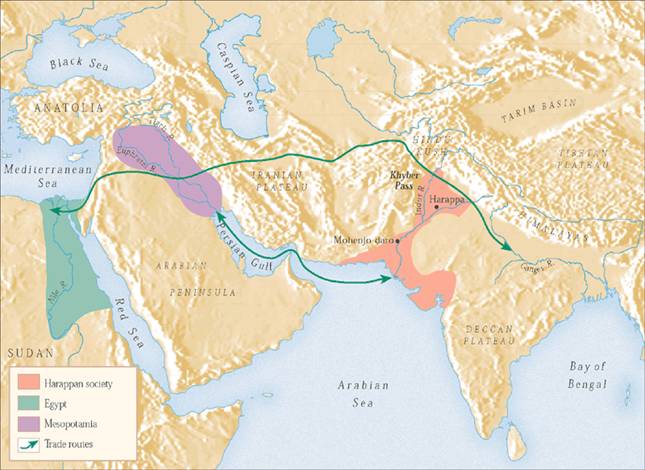
AN Ghosh (1910-1981) was an Indian archaeologist, author and editor. He postulates that "The cessation of trade at about 1900 B.C. must have had an adverse effect on the prosperity of the Harappan Civilisation and must therefore have been one of the factors leading to the decay of the cities, to the deurbanisation of the civilisation and to the dispersal of the population" (Ghosh 1980: 322). Ghosh then states that due to the plethora of natural disasters which befell the Harappans, "the people were evidently so overwhelmed by their own troubles that they could no longer pursue the luxury of foreign trade" (Ghosh 1980: 322). See Ancient Pakistan: An Archaeological History Vol 5. By Mukhtar Ahmed 2014)
Theory of ecological degradation/ deforestation by the people ie wearing out of landscape, proposed by SP Gupta in 1980
SP Gupta (1931-2007) was a prominent Indian archaeologist and historian. Dr Gupta remained a bachelor throughout his life. He authored many book on archaeology entitled Frontiers of the Indus Civilisation (BB Lal and SP Gupta, New Delhi, 1984, The Lost Sarasvati and the Indus Civilisation, Jodhpur, 1984, and The Indus Sarasvati Civilisation, Delhi, 1996. George Dales aptly noted that,” wearing out a landscape is basically impossible to prove and no alluvial plain wears out anyway.” Also, “if environmental factors had been decisive in the downfall of civilisations and Mesopotamia would have been deserted long ago”. (Gupta 1980:52) According to Dr Sanjeev Kumar, “In other words, although Mother Nature weakened have on several significant portions of the Harappan region as discussed above, the Harappans themselves would not have been able to change their environmental setting to such an extend as to have any being on their ability to sustain themselves. The decline can be seen around 1900 BC. Structures like housea, shops, wells and drains were poorly constructed with re used material. It indicates a shortage of natural resources such as clay for bricks and timber for building frames.” (Kostman, 1996)
The cultural process, ie societal evolution/devolution proposed by Gupta was also followed by Fairservis (1971 & 1979) and Schaffer (1982) Due to the cutting down of jungles or deforestation, many of the wild animals and birds became extinct in the Indus cities – for example elephants, rhinoceroses, tigers and crocodiles. Wood-related professions declined, which affected boatmakers, kiln workers, carpenters, potters, masons, etc. Honey, herbs and wines disappeared, which were main trading items. Meluhan birds, dogs and villages are mentioned in these inscriptions.
GL Possehl’s Theory of Transformation of Indus Valley Civilisation in 1989
Gregory Louis Possehl (1941-2011) was a professor emeritus of anthropology at the University of Pennsylvania and curator of the Asian Collections at the University of Pennsylvania Museum of Archaeology and Anthropology. He authored many books on the Indus Valley Civilisation. Possehl proposes Economic Decline and the General Abandonment of the Indo Iranian Borderlands by Farmers of Developed Villages in his book, Ancient Cities of the Indus (Page 75) published from New Delhi in 1979.
Possehl's forwards his hypothesis that, "The cause of the decline of the Indus Civilisation was at its heart, its ideological core: nihilism, urbanisation and socio cultural complexity (iconographic themes of ideology like figurines, pottery seals and other glyptic items).” GL Possehl opined that it was the state that died, not the Harappan Civilisation or its material culture.
The desertification of Cholistan: changes in hydrographic patterns proposed by Dr Rafique Mughal in 1990
RD Banerji the first excavator of Mohenjo-Daro writes in his Mohenjo-Daro: A forgotten Report (1926) that he discovered 18 beds of the River Indus between Mohenjo-Daro and Khirthar Range. This report was published by Prithivi Prakashan Varnasi-221 005 India, 1984. Many of the archaeologists, experts and historians believe that Indus Cities like Mohenjo-Daro were ruined due to the changing in the courses of River Indus and its natural channels.
Dr Muhammad Rafiq Mughal one of the leading archaeologists of Pakistan discovered 50 sites in the Cholistan/ Bahawalpur area along Sarasvati Ghaghar Hakra river banks. He continued field and research work in 1980, 1982, 1984 and 1990. He presented Theory of Changes in Hydrographic Pattern of River Indus in Lahore Museum Bulletin which was published Vol 3 No 2, July December 1990. Dr Muhammad Rafiq Mughal discussing his theory writes “Changes in the hydrographic pattern of the Indus Valley could have been one of the causes of decline” (Page 11)
Theory of decline and legacy of the Indus cities proposed by Mark Kenoyer in 1998
Describing the decline and legacy of the Indus cities, Dr Jonathan Mark Kenoyer writes in his book entitled Ancient Cities of the Indus Valley Civilisation, Karachi, 1998, “Factors that played a role in the decline of the Indus Cities are as diverse as those which stimulated their growth. In the core regions of the Indus and Ghaghar Hakra Valley, the wide extension of trade networks and political alliances was highly vulnerable to relatively minor changes in the environment and agriculture base. Due to sedimentation and tectonic movement, some water that would normally would have flowed into the ancient Saraswati river system was captured by two adjacent rivers, the Sutlaj River of the Indus system to the west, and the Yamuna River of the Gangetic system to the east. With the increase in water flow, the Indus itself began to swing east, flooding many settlements and burying them with silt. (Page 173)
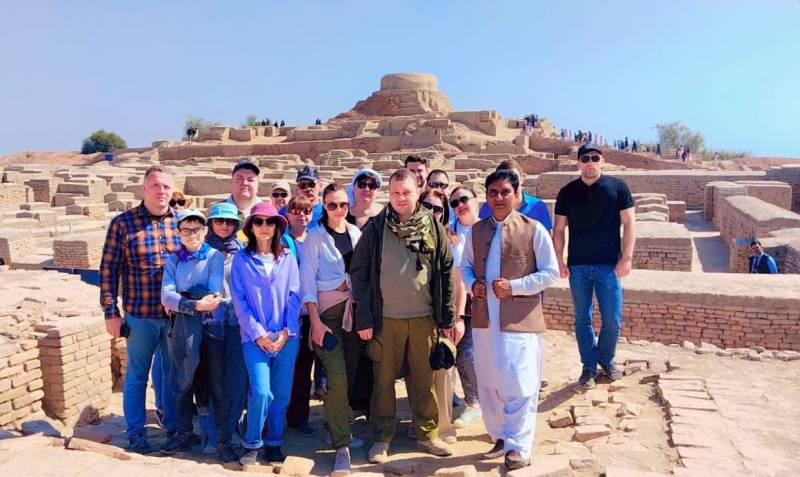
Dr Mark Kenoyer further writes that, “The mounds of Mohenjo-daro survived because they were on slightly higher land and were protected by massive mud brick walls and platforms, but many smaller sites were destroyed. Extensive repeated flooding, combined with shifting rivers, had a devastating effect on the agricultural foundation and economic structure of the Indus Cities. Although sites such as Harappa continued to be inhabited, the economic infrastructure for long distance trade to the south was irreparably damaged as many less fortunate settlements along the dry bed of the ancient Saraswati River were abandoned. The refugees were forced to develop new subsistence strategies or move to more stable agricultural regions.” (Page 173)
Theory of monsoon failure/drought proposed by geologist Anil Gupta in 2018
According to a new research by Geologist Anil Gupta of IIT Khargpur, it was monsoon which was responsible for the demise of the Indus Valley Civilisation. He conducted the study which shows that “From 2,350 BC (4,350 years ago) till 1,450 BC, the monsoon had a major weakening effect over the zone where the civilisation flourished. A drought like situation developed, forcing residents to abandon their settlements in search of greener pastures. This study was conducted in the Tso Moriri Lake in Ladakh, India. He added that the people gradually migrated from the Indus Valley to the Ganga-Yamuna valley in eastern and central Uttar Pradesh; Bihar and Bengal in the east; MP, south of Vindhyachal and south Gujarat in the south.”
He also added that there was hardly any rain in the northwest Himalayas for 900 long years. "What wiped out the Indus Valley Civilisation? A 900 year long drought. This led to the drying up of the source of water that fed the rivers along which the civilisation thrived, such as Indus and Sutlej. This forced the inhabitants towards the eastern and southern parts of the sub-continent."
Conclusion
It must be noted that some archaeologists, experts and historians have also suggested following causes as contributing to the decline or collapse of Indus Valley Civilisation:
- Overcrowding in the Indus cities
- Political crises among the ruling elites
- Economic and social decline
- Lack of Military Power and weapons
- Banditry along Indus trade routes
- Conflicts in states, chiefdoms and tribes
- Migration to south and east
- Cultural processes

